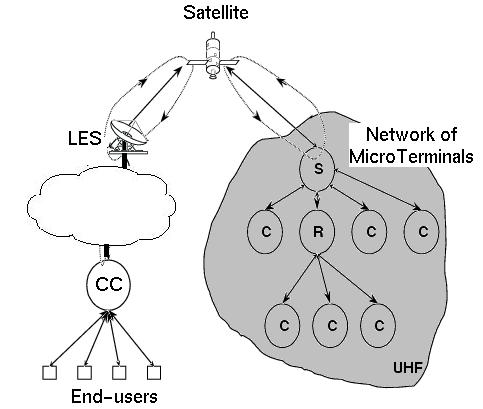
SONIC is an acronym for Self-Organizing Network of
Independent Components.
The goal of the SONIC project is to define mechanisms to self-organize a set of small wireless sensor devices (called microTerminals, or mT for short) into a network. One of the applications of such an network is collaborative data sensing and relaying the data in an aggregated manner to the remote control centers.

Consider the example application shown in the above figure. In this example, each mT is equipped with a UHF wireless interface and a GPS interface, and some special subset of the mTs are additionally equipped with a satellite interface. The goal of the mTs is to appropriately gather sensor data and transmit them via the satellite interfaces to the remote users connected to a command center. The satellite medium is the most expensive resource in terms of both battery power consumption and uplink bandwidth. Therefore, the goal of SONIC is to organize the set of mTs into a small number of networks, and maximally aggregate the information so as to minimally load the satellite link. Additionally, the battery-power at the mTs is a scarce resource, and so the protocols need to be energy conserving in nature.
For this application, we have defined a suite of protocols that operate end-to-end and allow the end-users to adaptively monitor the operations the mTs.
The protocols for this application was developed as part of the SkyTrack product, at the Maryland Network Research Corporation, Ashton, MD and are propreitary, under the terms of a Non-Disclosure Agreement.
Screenshots from the simulator of the SONIC distributed self-organizing network creation, by the mTs.
| Last updated on Jan 2000 | -- Suman |